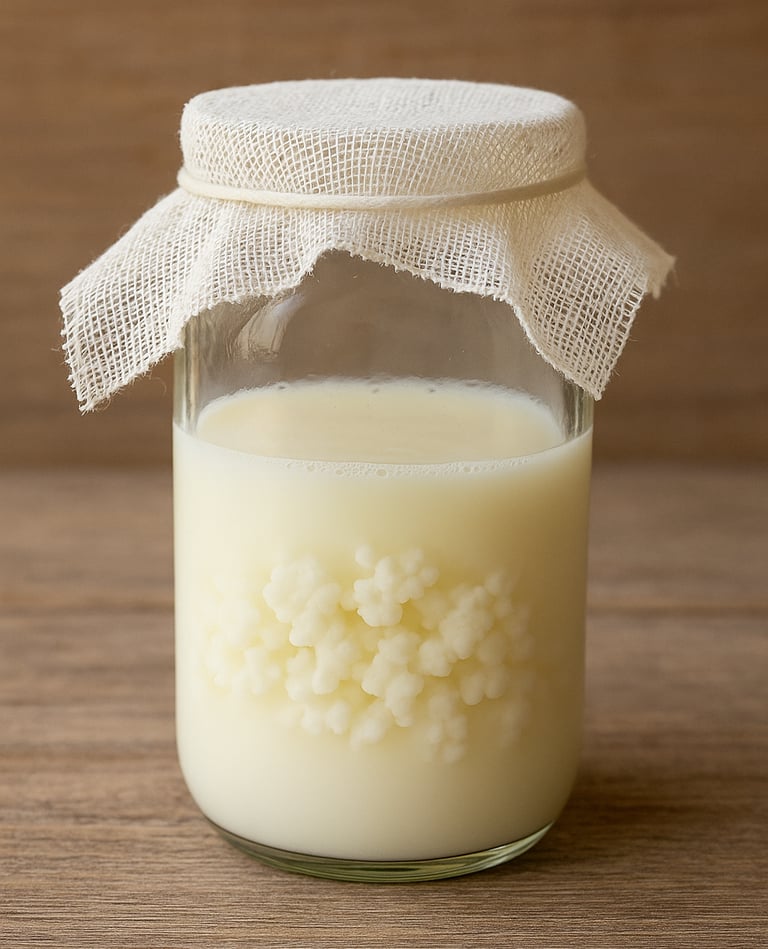Kefir: Benefits, Side Effects, and a Complete Guide to Making and Storing It
“Discover kefir’s benefits and side effects, the right daily amount, how to make it at home, and the best ways to store kefir grains.”


Kefir: Benefits, Side Effects, and a Complete Guide to Making and Storing It
Kefir is a traditional fermented milk drink made with kefir grains, rich in probiotics and nutrients that support digestion, immunity, and overall health. While it is widely considered a superfood, drinking too much kefir can sometimes cause unpleasant reactions. In this article, you’ll discover the side effects of kefir, how much you should consume daily, how to prepare it at home, and the best ways to store kefir grains long-term.
Possible Side Effects of Kefir – What Happens If You Drink Too Much
Although kefir is generally safe and well-tolerated, excessive consumption can lead to digestive discomfort. Common side effects include:
Bloating and gas – due to active fermentation in the gut.
Abdominal cramps and loose stools – especially if consumed in large amounts at once.
Discomfort for people with lactose intolerance, even though kefir contains much less lactose than milk.
Excess calories and sugars – when using store-bought, sweetened kefir.
Interactions with medications – probiotics can sometimes influence the absorption of antibiotics or other drugs.
These effects usually appear with intakes of 1 litre or more per day and typically go away once the amount is reduced.
The Optimal Daily Amount of Kefir
To enjoy its health benefits without negative effects, moderation is key.
Adults: about 200–250 ml per day (one glass) is ideal. Regular consumers can go up to 400–500 ml, preferably split into two servings.
Children: half of the adult portion, around 100–150 ml per day.
The best times to drink kefir are in the morning on an empty stomach, to stimulate digestion, or in the evening before bedtime, for a relaxing effect and to support bowel movements.
How to Make Kefir at Home – Simple Recipe
Making kefir at home is easy and inexpensive. All you need are kefir grains and fresh milk.
Place one tablespoon of kefir grains (about 10 g) in a clean glass jar.
Add 250 ml of milk at room temperature.
Cover with a cloth or a loosely fitted lid.
Leave to ferment for 24–48 hours at room temperature.
After 24 hours, the kefir will be mild and slightly tangy.
After 48 hours, it becomes thicker, more sour, and nearly lactose-free.
Strain out the grains, drink the kefir, and reuse the grains in a new batch.
How to Store Kefir Grains
Kefir grains are living cultures, and they multiply over time. To avoid waste, it’s essential to know how to preserve them.
Short-term storage (1–2 weeks)
Keep the grains in the fridge, covered with milk. Change the milk every few days to keep them active.
Long-term storage
There are two reliable methods:
Freezing – Place the grains in a small container, cover with a little milk, and freeze. They will last 4–6 months. To revive them, thaw slowly in the fridge and refresh them with new milk daily for a few days until they regain strength.
Drying – Rinse the grains gently and leave them to air-dry for 2–4 days in a cool, ventilated place (not direct sunlight). Once dry, store them in an airtight jar in a cool cupboard or fridge. Dried grains can last 6–12 months or longer. To reactivate, soak them in milk, changing the milk daily for several days.
Conclusion
Kefir is a potent probiotic drink that supports digestion, strengthens the immune system, and can easily be made at home. While it offers many benefits, it should be consumed in moderation — about one glass per day is enough for most adults.
With simple storage methods like freezing or drying, kefir grains can be preserved for months or even a year, ensuring you always have a healthy starter culture at hand. This makes kefir not just a delicious drink but a long-term ally for a balanced and healthy lifestyle.


